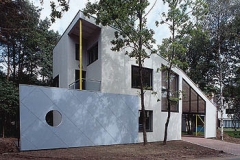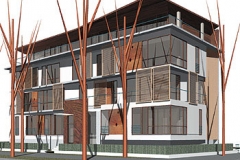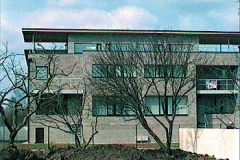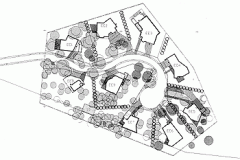Contrary to the opinion of many foreign colleagues in the early 1990s, who thought that a newly-independent and ex-socialist country would concentrate on building and
renovating private houses, a building boom of this kind has only now begun. The Quality of Dwelling was an exhibition organised by the Estonian Architects‰ Union in June 1998 (curated and designed by Inga Raukas and Toomas Tammis) which aimed to analyse the quality of contemporary residential architecture. It may be easy to appreciate a good car, but the ability to differentiate between houses sometimes requires the advice of a specialist. What is on offer today under the title of a high-quality modern house or apartment ranges drastically, from a late-19th-century-style division of space and planning in cardboard houses clad with imitation steel tiling, to kitsch buildings full of office-style laminates and new sheet-steel panelled boxes.
Architecture is always evaluated in association with everything exterior: usage, environment, worldview and general way of life. Values therefore are constantly changing, and high-quality residential architecture cannot be automatically secured by new and better materials or reverting to good old schemes. But it is possible to recognise quality by comparison. Estonian private houses today do not often display clear-cut architectural ideas or architecture which would harmonise perfectly with the environment. In comparison with the clear modernism of the 1960s (e.g. Raine Karp‰s house in MerivÉlja) and the postmodernism of the ė70s and ė80s (the best example is probably the house of Veljo Kaasik‰s brother in MerivÉlja) or the repetitions of modernism in the 1990s, there is now a more indistinct architecture which tries to use all possibilities simultaneously. The changes in residential architecture and its inner qualities may best be explained, not by stating generalities, but by indicating examples.
One of the essential key words here is planning: lack or insufficiency of which deprives even good houses of a significant quality of life. The most interesting example as for the environmental planning is the group of houses at the Vabażhukooli Road by architects KÄnnapu and Padrik. They have elegantly planned very small and heterogeneous 700 m2 plots, without gardens, and the result is a dense, varied environment. Similar dwelling districts in Tallinn which lack such efficient planning give quite a different effect.
Modern technologies moreover have completely upset notions of the value of several materials. Traditionally reliable and respectable, brick has become one of the cheapest and most boring materials, totally unable to satisfy the new needs of modern society. On the other hand, modern technology has turned lighter, traditionally less worthy, wall facings and fillings into amazingly flexible and relatively high-cost materials. In that sense, for instance, the exterior metal finish of architect Puusepp‰s office and apartment building in Raua street initiates an important dialogue with the wooden-clad houses in Kadriorg. Interesting wood-framed houses in Viimsi demonstrate another kind of simplicity and economical modernity by exploiting arrogant colours.
It is difficult to speak of programmatic and typological innovation in Estonian residential buildings; comparing functional solutions with those reached elsewhere, the only points that spring to mind are the popularity of the open-plan kitchen and other ways to achieve a wider practical living-space. The emerging hybrid houses which also have other functions besides living are quite interesting. Or typological hybrids, like Urmas Muru‰s terraced houses in Vżrse street which are transformed into 4-storey town houses. Many apartment-buildings described as ėcontemporary‰ by estate-agents fail to approach that description, either in quality of life or in apartment planning. Even the apartment houses designed by well-known architectural firms are just repetitions, with the exception of flats by Andres Alver and Tiit Trummal in which different programmatic alterations are clearly evident (the designs of buildings in Maakri and Weizenbergi streets).
Way of life is one of the most significant factors influencing residential architecture. Architecture contains much that is connected with imagology and the assessment of values. As with our choice of clothes which is determined not so much by the pattern of the fabric, buttons and embroidery, but by the activity for which the clothes are needed and by the weather stylishness also represents quality in architecture.








